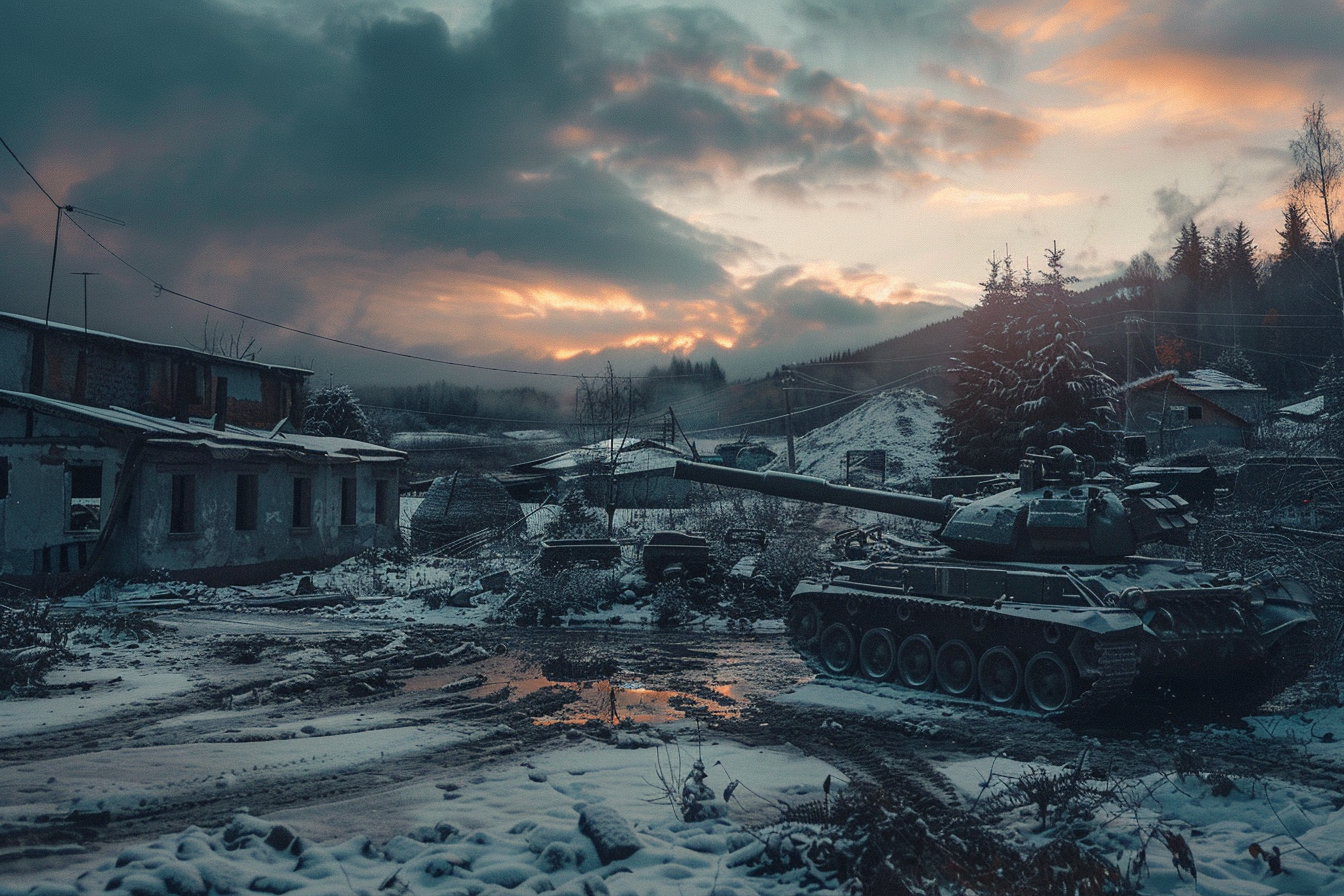
The Cold War, a period of geopolitical tension and ideological rivalry between the United States and the Soviet Union, lasted from the late 1940s to the late 1980s.
This era was marked by a series of significant events that shaped the course of international relations, global politics, and the lives of millions of people.
In this article, we’ll explore the key events of the Cold War, from the Iron Curtain to the Fall of the Berlin Wall, and examine their significance in the context of the global struggle between communism and democracy.
The Iron Curtain Descends (1945-1949)
The period from 1945 to 1949 marked the onset of the Cold War, a time of intense geopolitical rivalry and ideological conflict between the United States and the Soviet Union, which ultimately led to the division of Europe by the metaphorical “Iron Curtain.”
- Read also: Who Started the Cold War? A Look at the Beginning of a Tense Era
- Read also: The Lion Roars: Winston Churchill in the Cold War
Post-WWII tensions
After World War II, the United States and the Soviet Union emerged as the two superpowers with starkly different ideologies.
The US championed democracy, capitalism, and individual freedoms, while the USSR advocated for communism, centralized control, and state ownership of resources.
These ideological differences, combined with the competition for global influence, led to escalating tensions between the two nations.
Rise of Communist regimes in Eastern Europe and
Following the end of WWII, Soviet forces occupied Eastern European countries that had been liberated from Nazi control.
In the years that followed, communist governments sympathetic to the Soviet Union were established in countries such as Poland, Czechoslovakia, Hungary, and Bulgaria.
This consolidation of power in Eastern Europe raised concerns in the West about Soviet expansionism and the spread of communism.
The Truman doctrine
In response to these developments, President Harry S. Truman announced the Truman Doctrine in 1947.
This doctrine pledged to support nations threatened by communism and provided economic and military aid to countries resisting communist influence.
The Truman Doctrine represented a significant shift in US foreign policy towards containment, aiming to prevent the further spread of communism.
Berlin Blockade (1948-49)
In 1948, tensions between the US and USSR escalated further with the Berlin Blockade.
Soviet forces blocked all land and water routes into West Berlin, which was controlled by the Western Allies.
This blockade was an attempt to force the Allies to abandon West Berlin and consolidate control of the city under Soviet authority.
NATO Creation
The Berlin Blockade highlighted the deepening divide between East and West and underscored the need for collective security among Western nations.
In April 1949, twelve Western countries, including the United States, Canada, and several European nations, signed the North Atlantic Treaty, establishing the North Atlantic Treaty Organization (NATO).
NATO was formed as a defensive alliance aimed at deterring Soviet aggression and ensuring the security of its member states.

Proxy Wars and Nuclear Brinkmanship (1950s-1960s)
In the 1950s and 1960s, the Cold War between the United States and the Soviet Union manifested in proxy wars and nuclear brinkmanship, shaping global politics and security dynamics.
Korean war (1950-53)
The Korean War was a pivotal moment in Cold War history, marking the first major proxy conflict between the US and the USSR.
It began when North Korean forces, supported by the Soviet Union and China, invaded South Korea, which was backed by the United Nations and primarily the United States.
The war ended in an armistice, with Korea remaining divided along the 38th parallel, solidifying the split between communist North Korea and capitalist South Korea.
Vietnam war (1955-75) and other regional conflicts
The Vietnam War was another significant proxy conflict of the Cold War era.
It pitted North Vietnam, supported by communist allies such as the Soviet Union and China, against South Vietnam, backed by the United States and its allies.
The war served as a battleground for ideological competition between communism and capitalism, with devastating consequences for the Vietnamese people and profound social and political impacts on the US.
Nuclear arms race
The Cold War era was characterized by a dangerous nuclear arms race between the United States and the Soviet Union, as both countries sought to develop and stockpile increasingly powerful nuclear weapons.
The concept of mutually assured destruction (MAD) emerged, whereby the possession of nuclear weapons by both superpowers was believed to prevent direct conflict due to the catastrophic consequences it would entail.
Cuban missile crisis (1962)
The Cuban Missile Crisis of 1962 was a pivotal moment in the nuclear brinkmanship of the Cold War.
It occurred when the United States discovered that the Soviet Union was secretly deploying nuclear missiles in Cuba, just 90 miles from the US mainland.
This discovery led to a tense standoff between the two superpowers, with the world on the brink of nuclear war.

The Space Race and Détente (1950s-1970s)
During the 1950s to the 1970s, the United States and the Soviet Union engaged in a fierce competition known as the Space Race, while also experiencing periods of relaxation in tensions known as Détente.
The space race and Moon landing (1969)
The Space Race was a defining aspect of the Cold War rivalry between the US and the USSR.
It began in the late 1950s with the Soviet launch of Sputnik, the first artificial satellite, in 1957. This event shocked the world and prompted the United States to accelerate its own space program.
The competition escalated with milestones such as Yuri Gagarin becoming the first human in space in 1961 and the US landing the first humans on the moon during the Apollo 11 mission in 1969.
Neil Armstrong’s famous words, “That’s one small step for man, one giant leap for mankind,” marked a significant victory for the US in the Space Race and a momentous achievement for humanity as a whole.
Détente and key figures
Détente refers to a period of improved relations and reduced tensions between the US and the USSR during the 1970s.
This thaw in the Cold War was characterized by diplomatic dialogue, arms control agreements, and increased cultural exchanges.
Key figures during the Détente era included US President Richard Nixon and Soviet General Secretary Leonid Brezhnev.
Both leaders recognized the need to de-escalate tensions and pursue a more stable relationship between their two countries.
SALT I and SALT II Treaties
As part of the Détente era, the US and the USSR signed several arms control treaties aimed at limiting the proliferation of nuclear weapons and reducing the risk of nuclear war.
The Strategic Arms Limitation Talks (SALT) resulted in the signing of SALT I in 1972, which imposed limits on the number of intercontinental ballistic missiles (ICBMs) and submarine-launched ballistic missiles (SLBMs) each side could deploy.
This agreement represented a significant step towards arms control and stability between the two superpowers.
SALT II, signed in 1979 but never ratified by the US Senate, sought to further reduce nuclear arsenals and establish more stringent verification measures.

The Cold War Heats Up Again (1980s)
Soviet invasion of Afghanistan (1979)
In December 1979, the Soviet Union invaded Afghanistan to support the communist government against anti-government rebels.
This marked a significant escalation in the Cold War, as it directly challenged US interests in the region and raised concerns about Soviet expansionism.
The United States, along with other Western nations, responded by providing support to Afghan mujahideen fighters opposed to Soviet occupation.
This support included weapons, training, and financial assistance, turning Afghanistan into a battleground of Cold War proxy conflict.
Rise of solidarity movement in Poland
In Poland, the rise of the Solidarity movement in the early 1980s challenged Soviet-backed communist rule and represented a significant challenge to Soviet influence in Eastern Europe.
Solidarity, led by Lech Walesa, was a trade union and social movement that advocated for workers’ rights, political reform, and greater autonomy from Soviet control.
Its emergence signaled growing discontent with communist regimes and a desire for change among Eastern European populations.
The End of an Era (1980s-1991)

In the late 1980s and early 1990s, a series of events unfolded that led to the end of the Cold War era and the dissolution of the Soviet Union, marking a significant turning point in world history.
Mikhail Gorbachev’s reforms
Mikhail Gorbachev, who became General Secretary of the Communist Party of the Soviet Union in 1985, introduced a series of reform policies aimed at revitalizing the stagnant Soviet economy and addressing widespread social and political discontent.
Two key components of Gorbachev’s reforms were Glasnost, which means “openness,” and Perestroika, which means “restructuring.”
Glasnost involved greater transparency and freedom of expression, allowing for increased public debate and criticism of government policies
Fall of the Berlin Wall (1989)
The fall of the Berlin Wall on November 9, 1989, symbolized the collapse of the division between East and West and marked the beginning of the end of the Cold War.
The wall had been erected in 1961 by East Germany to prevent its citizens from fleeing to the West.
Dissolution of the Soviet Union (1991)
The official dissolution of the Soviet Union occurred on December 26, 1991, when Gorbachev resigned as Soviet president and the Soviet flag was lowered for the last time over the Kremlin.
This marked the end of a political entity that had dominated global affairs for much of the 20th century.
- Read also: Understanding the Differences: World War I Vs World War II
- Read also: A Battlefield Guide: Exploring the Major Battles of World War I
Conclusion
The Cold War was a complex and multifaceted conflict that spanned nearly five decades.
From the Iron Curtain to the Fall of the Berlin Wall, these key events shaped the course of international relations and global politics.
By understanding the context and significance of these events, we can gain a deeper appreciation for the complexities of the Cold War and its lasting impact on the world.



